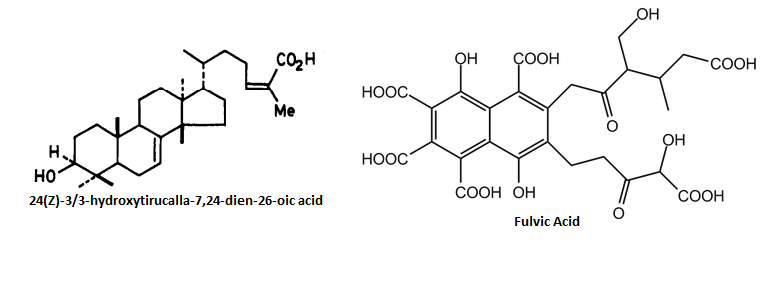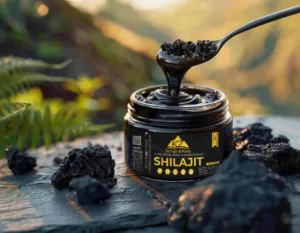Shilajit: The Ancient Himalayan Resin and Its Modern Health Benefits
Have you ever heard of a natural substance that oozes from rocks in the highest mountains, has been used for thousands of years in traditional medicine, and is now gaining global attention? Let’s explore the fascinating world of Shilajit—a sticky, tar-like substance that’s as mysterious as it is beneficial.
What is Shilajit?
Shilajit is a pale-brown to blackish-brown organic mineral substance that seeps from cracks in steep mountainous regions, particularly the Himalayas . Its name comes from Sanskrit and translates to “conqueror of mountains and destroyer of weakness”—quite a powerful name for a natural compound .
This sticky substance forms over centuries from the slow decomposition of plant material under intense pressure and temperature, aided by microbial activity . The result is a rich phytocomplex containing a unique combination of organic compounds, minerals, and trace elements.

The Chemical Composition of Shilajit
While the exact composition varies depending on geographic location and environmental conditions, researchers have identified several key components :
- Humic substances (making up to 80% of its weight), particularly fulvic acid (approximately 60%)
- Dibenzo-α-pyrones (DBPs) and their derivatives
- More than 40 minerals, including calcium, potassium, magnesium, iron, zinc, and copper
- Amino acids (mainly glycine) and proteins
- Fatty acids
- Bioactive compounds like caffeic acid and gallic acid
- Trace amounts of various other elements
Table: Major Components of Purified Shilajit
| Component | Percentage/Amount | Key Functions |
|---|---|---|
| Fulvic Acid | ~60% | Antioxidant, enhances nutrient transport |
| Minerals | ~20% total weight | Supports various bodily functions |
| Dibenzo-α-pyrones | Varies | Energy production, antioxidant |
| Trace Elements | Varies | Enzyme function, metabolic processes |
Historical Background and Traditional Uses
Shilajit has a rich history in Ayurvedic medicine, where it’s classified as a rasayana—a substance that improves the quality of plasma and all body tissues . Traditional practitioners have used it for thousands of years to treat a wide variety of conditions and promote overall vitality.
Interestingly, Shilajit was also used by dynastic Egyptians as a main constituent for mummification . This historical use across different ancient civilizations speaks to its preservative and healing properties.
Modern Research on Health Benefits
While traditional medicine has long celebrated Shilajit’s benefits, modern science is now catching up with clinical studies. Here’s what current research reveals:
1. Energy Enhancement and Anti-Fatigue Properties
If you’re struggling with low energy levels, Shilajit might help. Several studies have demonstrated its ability to combat fatigue and enhance physical performance:
- A 2019 study on recreationally active men found that 500 mg daily of PrimaVie® Shilajit for 8 weeks significantly reduced fatigue-induced strength decline compared to placebo .
- Research suggests Shilajit enhances mitochondrial function, increasing adenosine triphosphate (ATP) production—the primary energy currency of our cells .
- Another study showed that Shilajit helped reduce symptoms of chronic fatigue syndrome in animal models by preventing mitochondrial dysfunction .
2. Cognitive Health and Neuroprotection
One of the most promising areas of Shilajit research involves brain health:
- The fulvic acid in Shilajit may help prevent the accumulation of tau protein, which is associated with Alzheimer’s disease .
- Laboratory studies indicate that Shilajit components can break down existing amyloid plaques and prevent new ones from forming in the brain .
- Shilajit exhibits antioxidant properties that protect brain cells from damage caused by free radicals .
3. Skin Health and Anti-Aging Effects
Recent clinical research has revealed exciting benefits for skin health:
- A 14-week study on healthy adult women found that Shilajit supplementation (250 mg twice daily) improved skin microperfusion, enhancing blood flow to the skin .
- Shilajit was shown to induce genes relevant to endothelial cell migration and growth of blood vessels, supporting skin vitality .
- Its antioxidant and anti-inflammatory properties help protect skin from damage that leads to premature aging .
- Shilajit enhances collagen synthesis, which is crucial for maintaining skin’s structure and elasticity .
4. Male Reproductive Health
Shilajit shows particular promise for supporting male fertility and hormonal balance:
- A 90-day study on infertile men found that Shilajit supplementation significantly increased total sperm count in over 60% of participants .
- Another study demonstrated that purified Shilajit increased testosterone levels in healthy volunteers compared to placebo .
- More than 12% of study participants showed increased sperm motility after Shilajit supplementation .
5. Bone Health
For those concerned about bone density, especially during menopause, Shilajit may offer support:
- Research indicates Shilajit can help slow bone loss associated with osteoporosis .
- The mineral content in Shilajit, including magnesium, calcium, and other trace minerals, supports bone matrix formation and strength .
6. Anti-inflammatory and Antioxidant Effects
Chronic inflammation and oxidative stress are underlying factors in many health conditions:
- Shilajit contains compounds with significant anti-inflammatory properties, potentially helping conditions like eczema, psoriasis, and other inflammatory disorders .
- The fulvic acid in Shilajit acts as a powerful antioxidant, neutralizing harmful free radicals that damage cells .
- Some research suggests Shilajit has immunomodulatory properties, meaning it can help balance immune function as needed .
Safety Considerations and Potential Side Effects
While Shilajit offers numerous potential benefits, it’s crucial to understand safety considerations:
Choosing Safe Shilajit Products
The most important safety consideration involves product quality:
- Avoid raw, unprocessed Shilajit: Natural Shilajit may contain contaminants including heavy metals (aluminum, arsenic, cadmium, chromium, mercury, thallium, lead), fungi, and other impurities .
- Look for purified products: Processed Shilajit that has been purified and standardized is generally considered safe .
- Third-party testing: Choose brands that have been tested by independent laboratories and provide a certificate of analysis (COA) .
- Standardized extracts: Products like PrimaVie® Shilajit used in clinical studies have specific standardization for active components .
Potential Side Effects and Interactions
When using properly purified Shilajit, side effects appear to be minimal, but may include:
- Gastrointestinal issues such as nausea, vomiting, or diarrhea
- Allergic reactions in sensitive individuals
- Potential hormonal effects due to increased testosterone
- Possible interactions with medications for diabetes, hypertension, or hormone-sensitive conditions
Who Should Avoid Shilajit?
Certain individuals should exercise caution or avoid Shilajit:
- Pregnant or breastfeeding women (due to insufficient safety data)
- People with sickle cell anemia, hemochromatosis, or thalassemia
- Individuals with active heart disease
- Those scheduled for surgery (discontinue at least 2 weeks prior)
- People taking medications for blood sugar control, blood pressure, or hormone-sensitive conditions
How to Use Shilajit: Dosage and Forms
Shilajit is available in several forms, each with different considerations:
Available Forms
- Capsules: Convenient and pre-measured, ideal for consistent dosing
- Powder: Can be mixed with beverages like milk
- Resin: Considered the purest form, typically dissolved in liquid
- Liquid: Ready-to-use formulations
Recommended Dosage
Based on clinical studies, typical dosages range from:
- 200-500 mg daily for general health and wellness
- 250 mg twice daily for skin health benefits
- 500 mg daily for physical performance enhancement
Most studies have used supplementation periods ranging from 8 weeks to 48 weeks, with effects typically becoming noticeable after several weeks of consistent use .
The Future of Shilajit Research
While current research is promising, scientists acknowledge that more rigorous studies are needed:
- Larger-scale human clinical trials are necessary to confirm preliminary findings
- Standardization of Shilajit products for consistent composition and effects
- Long-term safety studies beyond the current 48-week data
- Research on potential drug interactions and mechanisms of action
Conclusion: Is Shilajit Right for You?
Shilajit represents a fascinating bridge between ancient traditional medicine and modern scientific inquiry. With its unique composition of fulvic acid, minerals, and bioactive compounds, it offers potential benefits for energy, cognitive function, skin health, reproductive wellness, and more.
Important Note: Always consult with a healthcare provider before starting any new supplement, especially if you have pre-existing health conditions or take medications. Choose purified, third-party tested Shilajit from reputable sources to ensure safety and quality.




Add comment